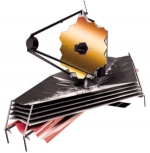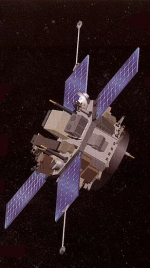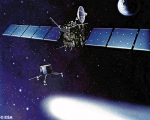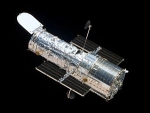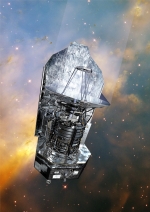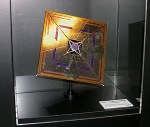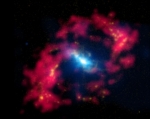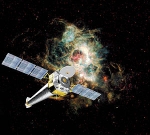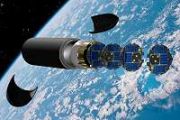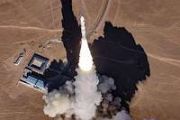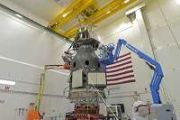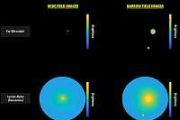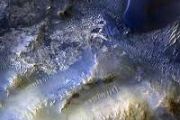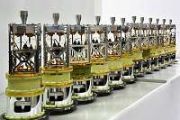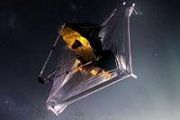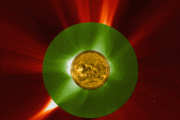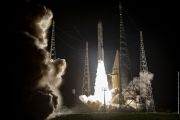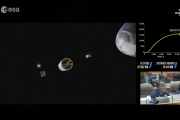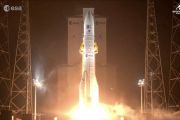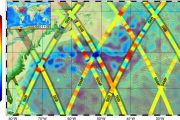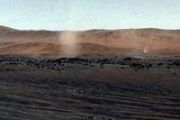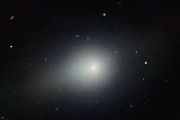Displaying items by tag: deep space
Jet Propulsion Laboratory (JPL)
The Jet Propulsion Laboratory (JPL) is a federally funded research and development center and NASA field center located in California, USA. JPL is managed by the nearby California Institute of Technology (Caltech) for the National Aeronautics and Space Administration (NASA).
The Laboratory's primary function is the construction and operation of robotic planetary spacecraft, though it also conducts Earth-orbit and astronomy missions. It is also responsible for operating NASA's Deep Space Network.
Among the Laboratory's major projects are the Mars Science Laboratory mission (which includes the Curiosity rover), the Cassini–Huygens mission orbiting Saturn, the Mars Exploration Rovers (Spirit and Opportunity), the Mars Reconnaissance Orbiter, the Dawn mission to the dwarf planet Ceres and asteroid Vesta, the Juno spacecraft en route to Jupiter, the Gravity Recovery and Interior Laboratory (GRAIL) mission to the Moon, the Nuclear Spectroscopic Telescope Array (NuSTAR) X-ray telescope, and the Spitzer Space Telescope.
James Webb Space Telescope (JWST)
The James Webb Space Telescope (JWST), previously known as Next Generation Space Telescope (NGST), is a planned space telescope optimized for observations in the infrared, and a scientific successor to the Hubble Space Telescope and the Spitzer Space Telescope. The main technical features are a large and very cold 6.5 meter diameter mirror, an observing position far from Earth, orbiting the Earth–Sun L2 point, and four specialized instruments. The combination of these features will give JWST unprecedented resolution and sensitivity from long-wavelength visible to the mid-infrared, enabling its two main scientific goals — studying the birth and evolution of galaxies, and the formation of stars and planets.
Organization: NASA, with significant contributions from ESA and CSA.
ACE (spacecraft)
Advanced Composition Explorer (ACE) is a NASA space exploration mission being conducted as part of the Explorer program to study matter in situ, comprising energetic particles from the solar wind, the interplanetary medium, and other sources. Real-time data from ACE is used by the Space Weather Prediction Center to improve forecasts and warnings of solar storms. The ACE robotic spacecraft was launched August 25, 1997 and is currently operating in a Lissajous orbit close to the L1 Lagrange point (which lies between the Sun and the Earth at a distance of some 1.5 million km from the latter). The spacecraft is still in generally good condition, and has enough fuel to maintain its orbit until 2024. NASA Goddard Space Flight Center managed the development and integration of the ACE spacecraft.
Instrumentation
- Cosmic Ray Isotope Spectrometer (CRIS): CRIS determines the isotope composition of galactic cosmic rays. It is designed to be sensitive enough to detect isotopes up to the range of zinc (Z-30).
- ACE Real Time Solar Wind (RTSW).
- Solar Wind Ion Mass Spectrometer (SWIMS) and Solar Wind Ion Composition Spectrometer (SWICS): These two instruments are time-of-flight mass spectrometers, each tuned for a different set of measurements. They analyze the chemical and isotopic composition of solar wind and interstellar matter.
- Ultra-Low Energy Isotope Spectrometer (ULEIS): ULEIS measures ion flux and is sensitive to a range from helium through nickel to determine the makeup of solar energetic particles and the mechanism by which the particles become charged by the sun.
- Solar Energetic Particle Ionic Charge Analyzer (SEPICA): As of 2008, this instrument is no longer functioning due to failed gas valves.
- Solar Isotope Spectrometer (SIS).
- Solar Wind Electron, Proton and Alpha Monitor (SWEPAM).
- Electron, Proton, and Alpha-particle Monitor (EPAM).
- Magnetometer (MAG).
Rosetta spacecraft
Rosetta is a robotic spacecraft of the European Space Agency on a mission to study the comet 67P/Churyumov–Gerasimenko. Rosetta consists of two main elements:
- the Rosetta space probe;
- the Philae lander.
The spacecraft was launched on 2 March 2004 on an Ariane 5 rocket and will reach the comet by mid 2014. The space probe is intended to orbit and perform long-term exploration of the comet at close quarters. On 10 November 2014 the Philae lander will attempt to land and perform detailed investigations on the comet's surface. Both the probe and the lander carry a large complement of scientific experiments designed to complete the most detailed study of a comet ever attempted.
The probe is named after the Rosetta Stone, as it is hoped the mission will help form an idea of how the solar system looked before planets formed. The lander is named after the Nile island Philae where an obelisk was found that helped decipher the Rosetta Stone. The spacecraft has already performed two successful asteroid flyby missions on its way to the comet. In 2007 performed a Mars swingby (flyby), and returned images. The craft completed its fly-by of asteroid 2867 Šteins in September 2008 and of 21 Lutetia in July 2010, and is presently (2013) in hibernation and on-target for its final destination as of June 2013.
Hubble Space Telescope
The Hubble Space Telescope (HST) is a space telescope that was carried into orbit by a Space Shuttle in 1990 and remains in operation. A 2.4 meter (7.9 ft) aperture telescope in low Earth orbit, Hubble's four main instruments observe in the near ultraviolet, visible, and near infrared. The telescope is named after the astronomer Edwin Hubble.
Hubble's orbit outside the distortion of Earth's atmosphere allows it to take extremely sharp images with almost no background light. Hubble's Ultra-Deep Field image, for instance, is the most detailed visible-light image ever made of the universe's most distant objects. Many Hubble observations have led to breakthroughs in astrophysics, such as accurately determining the rate of expansion of the universe.
Although not the first space telescope, Hubble is one of the largest and most versatile, and is well known as both a vital research tool and a public relations boon for astronomy. The HST was built by the United States space agency NASA, with contributions from the European Space Agency, and is operated by the Space Telescope Science Institute. The HST is one of NASA's Great Observatories, along with the Compton Gamma Ray Observatory, the Chandra X-ray Observatory, and the Spitzer Space Telescope.
Space telescopes were proposed as early as 1923. Hubble was funded in the 1970s, with a proposed launch in 1983, but the project was beset by technical delays, budget problems, and the Challenger disaster. When finally launched in 1990, scientists found that the main mirror had been ground incorrectly, significantly compromising the telescope's capabilities. However, after a servicing mission in 1993, the telescope was restored to its intended quality.
Hubble is the only telescope designed to be serviced in space by astronauts. Between 1993 and 2002, four missions repaired, upgraded, and replaced systems on the telescope, but a fifth mission was canceled on safety grounds following the Columbia disaster. However, after spirited public discussion, NASA administrator Mike Griffin approved one final servicing mission, completed in 2009. The telescope is now expected to function until at least 2014. Its scientific successor, the James Webb Space Telescope (JWST), is to be launched in 2018 or possibly later.
Herschel Space Observatory
A space telescope observing in the far-infrared.
The Herschel Space Observatory is a European Space Agency space observatory sensitive to the far infrared and submillimetre wavebands. It is the largest infrared space telescope ever launched, carrying a single mirror of 3.5 metres (11.5 ft) in diameter.
The observatory was carried into orbit in May 2009, reaching the second Lagrangian point (L2) of the Earth-Sun system, 1,500,000 kilometres (930,000 mi) from the Earth, about two months later. Herschel is named after Sir William Herschel, the discoverer of the infrared spectrum and planet Uranus.
The Herschel Observatory is capable of seeing the coldest and dustiest objects in space; for example, cool cocoons where stars form and dusty galaxies just starting to bulk up with new stars. The observatory will sift through star-forming clouds—the "slow cookers" of star ingredients—to trace the path by which potentially life-forming molecules, such as water, form. The United States through NASA is participating in the ESA-built and -operated observatory. It is the fourth 'cornerstone' mission in the ESA science program, along with Rosetta, Planck, and the Gaia mission.
IKAROS
IKAROS (Interplanetary Kite-craft Accelerated by Radiation Of the Sun) is a Japan Aerospace Exploration Agency (JAXA) experimental spacecraft. The spacecraft was launched on 21 May, 2010, aboard an H-IIA rocket, together with the Akatsuki (Venus Climate Orbiter) probe and four other small spacecraft. IKAROS is the first spacecraft to successfully demonstrate solar-sail technology in interplanetary space.
On December 8, 2010, IKAROS passed by Venus at about 80,800 km distance, completing the planned mission successfully, and entered its extended operation phase.
The IKAROS probe is the world's first spacecraft to use solar sailing as the main propulsion. It plans to demonstrate four key technologies (comments in parentheses refer to figure):
- Deployment and control of a large, thin solar sail membrane (blue areas numbered 3)
- Thin-film solar cells integrated into the sail to power the payload (black rectangles numbered 4)
- Measurement of acceleration due to radiation pressure on the solar sail
- Attitude control via variable reflectance liquid crystal panels (orange rectangles numbered 2)
The mission also includes investigations of aspects of interplanetary space, such as the gamma-ray burst, solar wind and cosmic dust.
The probe's ALADDIN instrument (ALDN-S and ALDN-E) measured the variation in dust density while its Gamma-Ray Burst Polarimeter (GAP) measured the polarization of gamma-ray bursts during its six month cruise.
If successful, IKAROS is to be followed by a 50 m (160 ft) sail, intended to journey to Jupiter and theTrojan asteroids, later in the decade.
XMM-Newton
The XMM-Newton (X-ray Multi-Mirror Mission - Newton) is an orbiting X-ray observatory launched by ESA in December 1999 on a Ariane 5 rocket. It is named in honor of Sir Isaac Newton.
Its mission is turned towards deep space and aimes to increasing our knowledge of very hot objects created when the Universe was very young,
Originally known as the High Throughput X-ray Spectroscopy Mission it was placed in a very eccentric 48 hour elliptical orbit at 40°; at its apogee it is nearly 114,000 kilometres (71,000 mi) from Earth, while theperigee is only 7,000 kilometres (4,300 mi)
The satellite weighs 3,800 kilograms (8,400 lb), is 10 metres (33 ft) long and 16 metres (52 ft) in span with its solar arrays deployed. It holds three X-ray telescopes, developed by Media Lario of Italy, each of which contains 58 Wolter-type concentric mirrors. The combined collecting area is 4,300 cm². The three European Photon Imaging Cameras (EPIC) are sensitive over the energy range 0.2 keV to 12 keV. Other instruments onboard are two reflection grating spectrometers which are sensitive below ~2 keV, and a 30 centimetres (12 in) diameter Ritchey-Chretien optical/UV telescope.
The mission was proposed in 1984 and approved in 1985; a project team was formed in 1993 and development work began in 1996. The satellite was constructed and tested from March 1997 to September 1999. Launched in Dec 1999, in-orbit commissioning started Jan 2000. First images published Feb 2000. The original mission lifetime was two years, it has now been extended for further observations until at least 2010, and again until 2012, and technically could operate until 2018.
Observations are managed and archived at the European Space Astronomy Centre (formerly known as VILSPA) at Villafranca, Spain. The data are processed at the XMM-Newton Survey Science Centre at the University of Leicester, England.
The European satellite XMM-Newton (X-ray Multi Mirror), built under contract to ESA by a consortium of 35 European companies with Astrium as prime contractor, by far excels its predecessor, the Astrium-built ROSAT satellite.
Nasa telescopes have unearthed a scowling eye in deep space
Images from three Nasa telescopes seem to have unearthed a scowling eye in deep space - but it's actually a nearby galaxy - NGC 4151 - with gas interacting with the growing black hole at its centre.
The white 'pupil' is the black hole - and the red 'brow' is hydrogen, a gravity-warped structure at the galaxy's heart that includes material falling towards its centre.
The blue is X-rays which scientists are studying to understand how such black holes interact with the gas around them.
What seems to be an 'evil eye' is in fact hydrogen surrounding the heart of a galaxy with a supermassive black hole at its centre - NGC 4131, one of the nearest galaxies with an actively growing black hole
'It looks like a really evil eye to me,' the blog Gizmodo said this week. 'It's a photo of the central region of NGC 4151, a spiral galaxy 43 millions light years away from Earth.'
NGC 4151 is one of the nearest galaxies that contains an actively growing black hole.
It offers one of the best chances of studying the interaction between an active supermassive black hole and the surrounding gas of its host galaxy.
Such interaction, or feedback, is recognized to play a key role in the growth of supermassive black holes and their host galaxies.
Scientists are now studying why such a huge amount of X-rays (blue) is released - in an effort to understand how supermassive black holes interact with the gases around them.
The resemblance to a huge, evil eye seems to be pure coincidence.
The scowling red 'eyebrow' is actually hydrogen detected by radio observations with the NSF's Very Large Array.
The composite image shows the central region of the spiral galaxy NGC 4151 in a combination of X-rays (blue) from the Chandra X-ray Observatory with optical data (yellow) showing positively charged hydrogen (H II) from observations with the 1-meter Jacobus Kapteyn Telescope on La Palma.
The yellow blobs around the red ellipse are areas where stars recently formed.
source and read more: www.dailymail.co.uk
Chandra X-ray Observatory
The Chandra X-ray Observatory is a satellite launched on STS-93 by NASA on July 23, 1999. It was named in honor of Indian-American physicist Subrahmanyan Chandrasekharwho is known for determining the maximum mass for white dwarfs. "Chandra" also means "moon" or "luminous" in Sanskrit.
Chandra Observatory is the third of NASA's four Great Observatories. The first was Hubble Space Telescope; second the Compton Gamma Ray Observatory, launched in 1991; and last is the Spitzer Space Telescope. Prior to successful launch, the Chandra Observatory was known as AXAF, the Advanced X-ray Astrophysics Facility. AXAF was assembled and tested by TRW (now Northrop Grumman Aerospace Systems) in Redondo Beach,California. Chandra is sensitive to X-ray sources 100 times fainter than any previous X-ray telescope, due primarily to the high angular resolution of the Chandra mirrors.
Since the Earth's atmosphere absorbs the vast majority of X-rays, they are not detectable from Earth-based telescopes, requiring a space-based telescope to make these observations.


